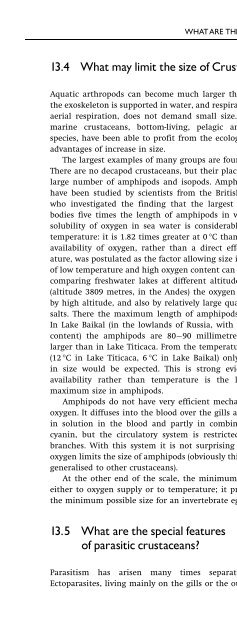An Introduction to the Invertebrates, Second Edition - tiera.ru
An Introduction to the Invertebrates, Second Edition - tiera.ru
An Introduction to the Invertebrates, Second Edition - tiera.ru
Create successful ePaper yourself
Turn your PDF publications into a flip-book with our unique Google optimized e-Paper software.
WHATARE THE SPECIAL FEATURES OF PARASITIC CRUSTACEANS?17713.4 What may limit <strong>the</strong> size of C<strong>ru</strong>stacea?Aquatic arthropods can become much larger than terrestrial ones:<strong>the</strong> exoskele<strong>to</strong>n is supported in water, and respiration by gills, unlikeaerial respiration, does not demand small size. Accordingly manymarine c<strong>ru</strong>staceans, bot<strong>to</strong>m-living, pelagic and even intertidalspecies, have been able <strong>to</strong> profit from <strong>the</strong> ecological and metabolicadvantages of increase in size.The largest examples of many groups are found in <strong>the</strong> <strong>An</strong>tarctic.There are no decapod c<strong>ru</strong>staceans, but <strong>the</strong>ir place is taken by a verylarge number of amphipods and isopods. Amphipods in particularhave been studied by scientists from <strong>the</strong> British <strong>An</strong>tarctic Survey,who investigated <strong>the</strong> finding that <strong>the</strong> largest polar species havebodies five times <strong>the</strong> length of amphipods in warmer waters. Thesolubility of oxygen in sea water is considerably increased at lowtemperature: it is 1.82 times greater at 0 °C than at 30 °C. Increasedavailability of oxygen, ra<strong>the</strong>r than a direct effect of low temperature,was postulated as <strong>the</strong> fac<strong>to</strong>r allowing size increase. The effectsof low temperature and high oxygen content can be distinguished bycomparing freshwater lakes at different altitudes: in Lake Titicaca(altitude 3809 metres, in <strong>the</strong> <strong>An</strong>des) <strong>the</strong> oxygen content is reducedby high altitude, and also by relatively large quantities of dissolvedsalts. There <strong>the</strong> maximum length of amphipods is 22 millimetres.In Lake Baikal (in <strong>the</strong> lowlands of Russia, with no measurable saltcontent) <strong>the</strong> amphipods are 80 90 millimetres long, four timeslarger than in Lake Titicaca. From <strong>the</strong> temperature difference alone(12 °C in Lake Titicaca, 6 °C in Lake Baikal) only half this increasein size would be expected. This is strong evidence that oxygenavailability ra<strong>the</strong>r than temperature is <strong>the</strong> limiting fac<strong>to</strong>r formaximum size in amphipods.Amphipods do not have very efficient mechanisms of acquiringoxygen. It diffuses in<strong>to</strong> <strong>the</strong> blood over <strong>the</strong> gills and is carried partlyin solution in <strong>the</strong> blood and partly in combination with haemocyanin,but <strong>the</strong> circula<strong>to</strong>ry system is restricted, with few lateralbranches. With this system it is not surprising that availability ofoxygen limits <strong>the</strong> size of amphipods (obviously this finding cannot begeneralised <strong>to</strong> o<strong>the</strong>r c<strong>ru</strong>staceans).At <strong>the</strong> o<strong>the</strong>r end of <strong>the</strong> scale, <strong>the</strong> minimum size is not relatedei<strong>the</strong>r <strong>to</strong> oxygen supply or <strong>to</strong> temperature; it probably depends on<strong>the</strong> minimum possible size for an invertebrate egg.13.5 What are <strong>the</strong> special featuresof parasitic c<strong>ru</strong>staceans?Parasitism has arisen many times separately in C<strong>ru</strong>stacea.Ec<strong>to</strong>parasites, living mainly on <strong>the</strong> gills or <strong>the</strong> outer surface of fish,











